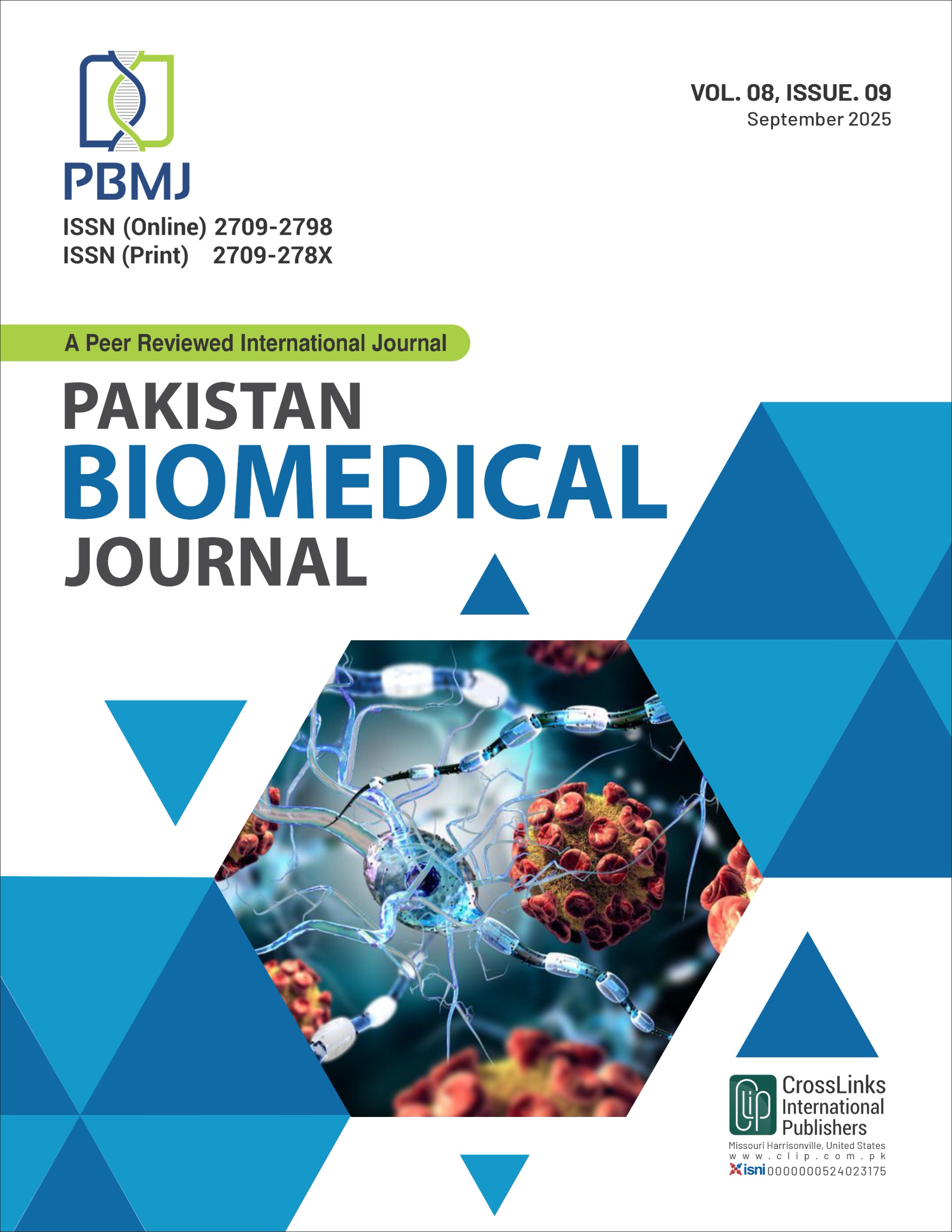Exploring Sleep Quality as a Modifiable Risk Factor for Suicidal Ideation among Young Students
Sleep Quality as a Modifiable Risk Factor for Suicidal Ideation
DOI:
https://doi.org/10.54393/pbmj.v8i9.1296Keywords:
Sleep, Suicidal Ideation, Students, Risk Assessment, Sleep Quality, Environmental FactorsAbstract
Sleep quality is a key modifiable factor that can influence suicidal ideation. While poor sleep is linked to suicidal thoughts, there is limited research on its effects in non-clinical young Students. Objectives: To examine how sleep disturbances, influenced by environmental factors such as living conditions and lifestyle, are related to suicidal ideation among students. Methods: A cross-sectional survey was conducted at the University of Punjab, Lahore, Pakistan, from March to June 2025. A total of 150 Young Students aged 15-30 years were recruited through purposive sampling. Participants completed the 13-item Sleep–Suicide Ideation Rating Scale (S-SIRS), a self-developed questionnaire designed to assess sleep quality and its perceived impact on suicidal thoughts. The S-SIRS was validated through reliability testing (Cronbach’s α = 0.748) and expert evaluation for content validity. Data analysis included Spearman’s correlation to explore the relationship between sleep disturbances and suicidal ideation, non-parametric tests for group comparisons, and Firth’s penalized-likelihood logistic regression to identify key predictors and address class imbalance. Results: A significant positive correlation was found between sleep disturbances and suicidal ideation (ρ=0.402, p<0.001). Hostel residents and female reported higher levels of both sleep disturbances and suicidal ideation. Sleep impairment was the strongest predictor, with each unit increase in sleep disturbance raising the odds of suicidal ideation by 23.3% (OR = 1.233, p<0.001). Conclusions: Sleep disturbances are strongly linked to suicidal ideation among students, with environmental factors influencing this relationship.
References
Simon KC, Nadel L, Payne JD. The functions of Sleep: A Cognitive Neuroscience Perspective. Proceedings of the National Academy of Sciences. 2022 Nov; 119(44): e2201795119. doi: 10.1073/pnas.2201795119. DOI: https://doi.org/10.1073/pnas.2201795119
Jahrami H, BaHammam AS, Bragazzi NL, Saif Z, Faris M, Vitiello MV. Sleep Problems During the COVID-19 Pandemic by Population: A Systematic Review and Meta-Analysis. Journal of Clinical Sleep Medicine. 2021 Feb; 17(2): 299-313. doi: 10.5664/jcsm.8930. DOI: https://doi.org/10.5664/jcsm.8930
Goldstein AN and Walker MP. The Role of Sleep in Emotional Brain Function. Annual Review of Clinical Psychology. 2014 Mar; 10(1): 679-708. doi: 10.1146/annurev-clinpsy-032813-153716. DOI: https://doi.org/10.1146/annurev-clinpsy-032813-153716
Littlewood DL, Kyle SD, Carter LA, Peters S, Pratt D, Gooding P. Short Sleep Duration and Poor Sleep Quality Predict Next-Day Suicidal Ideation: An Ecological Momentary Assessment Study. Psychological Medicine. 2019 Feb; 49(3): 403-11. doi: 10.1017/S0033291718001009. DOI: https://doi.org/10.1017/S0033291718001009
Xu H, Yang X, Lai X, Zhao C, Tu X, Ding N et al. Longitudinal Relationships Among Perceived Stress, Suicidal Ideation and Sleep Quality in Chinese Undergraduates: A Cross-Lagged Model. Journal of Affective Disorders. 2022 Feb; 299: 45-51. doi: 10.1016/j.jad.2021.11.033. DOI: https://doi.org/10.1016/j.jad.2021.11.033
Zou P, Wang X, Sun L, Liu K, Hou G, Yang W, Liu C et al. Poorer Sleep Quality Correlated with Mental Health Problems in College Students: A Longitudinal Observational Study among 686 Males. Journal of Psychosomatic Research. 2020 Sep; 136: 110177. doi: 10.1016/j.jpsychores.2020.110177. DOI: https://doi.org/10.1016/j.jpsychores.2020.110177
Liu RT, Steele SJ, Hamilton JL, Do QB, Furbish K, Burke TA et al. Sleep and Suicide: A Systematic Review and Meta-Analysis of Longitudinal Studies. Clinical Psychology Review. 2020 Nov; 81: 101895. doi: 10.1016/j.cpr.2020.101895.
Hamdan S, Apter A, Levi-Belz Y. Non-Suicidal Self-Injury Among Adolescents from Diverse Ethnocultural Groups in Israel: The Association with Sleep Problems and Internet Addiction. Frontiers in Psychiatry. 2022 May; 13: 899956. doi: 10.3389/fpsyt.2022.899956. DOI: https://doi.org/10.3389/fpsyt.2022.899956
Wu R, Wang CY, Wang F, Wang YJ, Zhu H, Wang GH et al. Association Between Sleep and Suicidal Ideation in Chinese Undergraduate Students. International Journal of Environmental Research and Public Health. 2022 Nov; 19(23): 15433. doi: 10.3390/ijerph192315433. DOI: https://doi.org/10.3390/ijerph192315433
Levin KA. Study Design III: Cross-Sectional Studies. Evidence-Based Dentistry. 2006 Mar; 7(1): 24-5. doi: 10.1038/sj.ebd.6400375. DOI: https://doi.org/10.1038/sj.ebd.6400375
Etikan I, Musa SA, Alkassim RS. Comparison of Convenience Sampling and Purposive Sampling. American Journal of Theoretical and Applied Statistics. 2016 Jan; 5(1): 1-4. doi: 10.11648/j.ajtas.20160501.11. DOI: https://doi.org/10.11648/j.ajtas.20160501.11
Boateng GO, Neilands TB, Frongillo EA, Melgar-Quiñonez HR, Young SL. Best Practices for Developing and Validating Scales for Health, Social, and Behavioral Research: A Primer. Frontiers in Public Health. 2018 Jun; 6: 149. doi: 10.3389/fpubh.2018.00149. DOI: https://doi.org/10.3389/fpubh.2018.00149
R Core Team. R: A Language and Environment for Statistical Computing. R Foundation for Statistical Computing, Vienna, Austria. 2021.
Shapiro SS and Wilk MB. An Analysis of Variance Test for Normality (Complete Samples). Biometrika. 1965 Dec; 52(3-4): 591-611. doi: 10.1093/biomet/52.3-4.591. DOI: https://doi.org/10.1093/biomet/52.3-4.591
Spearman C. The Proof and Measurement of Association Between Two Things. The American Journal of Psychology. 1987 Oct; 100(3/4): 441-71. doi: 10.2307/1422689. DOI: https://doi.org/10.2307/1422689
Tomczak M and Tomczak E. The Need to Report Effect Size Estimates Revisited. An Overview of Some Recommended Measures of Effect Size. rends Sport Science. 2014; 1(21): 19-25.
Firth D. Bias Reduction of Maximum Likelihood Estimates. Biometrika. 1993 Mar; 80(1): 27-38. doi: 10.1093/biomet/80.1.27. DOI: https://doi.org/10.1093/biomet/80.1.27
Liu RT, Steele SJ, Hamilton JL, Do QB, Furbish K, Burke TA et al. Sleep and Suicide: A Systematic Review and Meta-Analysis of Longitudinal Studies. Clinical Psychology Review. 2020 Nov; 81: 101895. doi: 10.1016/j.cpr.2020.101895. DOI: https://doi.org/10.1016/j.cpr.2020.101895
Cui G, Yin Y, Li S, Chen L, Liu X, Tang K et al. Longitudinal Relationships among Problematic Mobile Phone Use, Bedtime Procrastination, Sleep Quality and Depressive Symptoms in Chinese College Students: A Cross-Lagged Panel Analysis. BioMed Central Psychiatry. 2021 Sep; 21(1): 449. doi: 10.1186/s12888-021-03451-4. DOI: https://doi.org/10.1186/s12888-021-03451-4
Tian M, Lin L, Liu Y, Qiu S, Yang Y, Xu Z. The Relationship Between Sleep Quality and Suicidal Ideation in College Students: The Longitudinal Mediating Role of Negative Affect and the Neural Basis of This Relationship. Current Psychology. 2024 Oct; 43(37): 29385-98. doi: 10.1007/s12144-024-06574-5. DOI: https://doi.org/10.1007/s12144-024-06574-5
Zaidi SG, Zahra SK, Zaidi SZ, Aun SM. A Qualitative Study on the Effects of Homesickness on Mental Health and Sleep Among Newly Admitted Students Residing in Hostels in Public Universities of Punjab, Pakistan. Journal of Health and Rehabilitation Research. 2025 Feb: 1-6. doi: 10.61919/jhrr.v5i2.1760. DOI: https://doi.org/10.61919/jhrr.v5i2.1760
Althubaiti A. Information Bias in Health Research: Definition, Pitfalls, and Adjustment Methods. Journal of Multidisciplinary Healthcare. 2016 May: 211-7. doi: 10.2147/JMDH.S104807. DOI: https://doi.org/10.2147/JMDH.S104807
Buetow S and Zawaly K. Rethinking Researcher Bias in Health Research. Journal of Evaluation in Clinical Practice. 2022 Oct; 28(5): 843-6. doi: 10.1111/jep.13622. DOI: https://doi.org/10.1111/jep.13622
Downloads
Published
How to Cite
Issue
Section
License
Copyright (c) 2025 Pakistan BioMedical Journal

This work is licensed under a Creative Commons Attribution 4.0 International License.
This is an open-access journal and all the published articles / items are distributed under the terms of the Creative Commons Attribution License, which permits unrestricted use, distribution, and reproduction in any medium, provided the original author and source are credited. For comments editor@pakistanbmj.com











